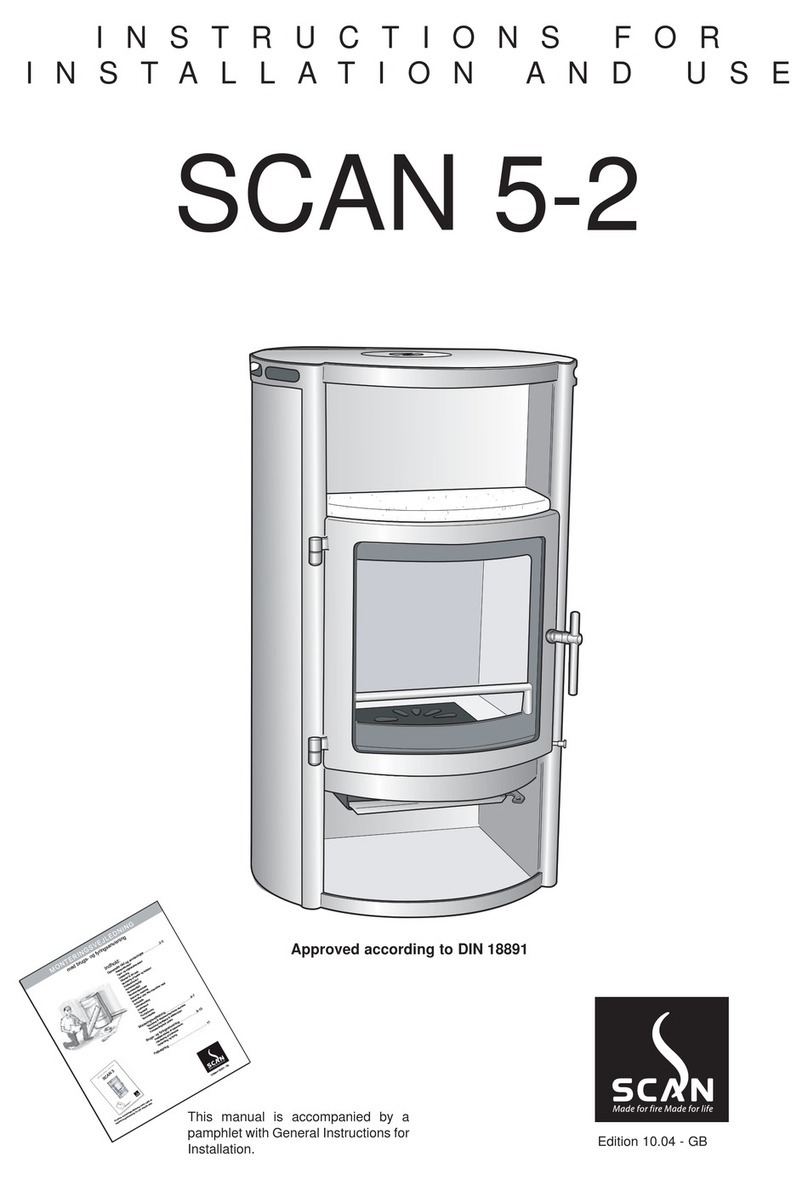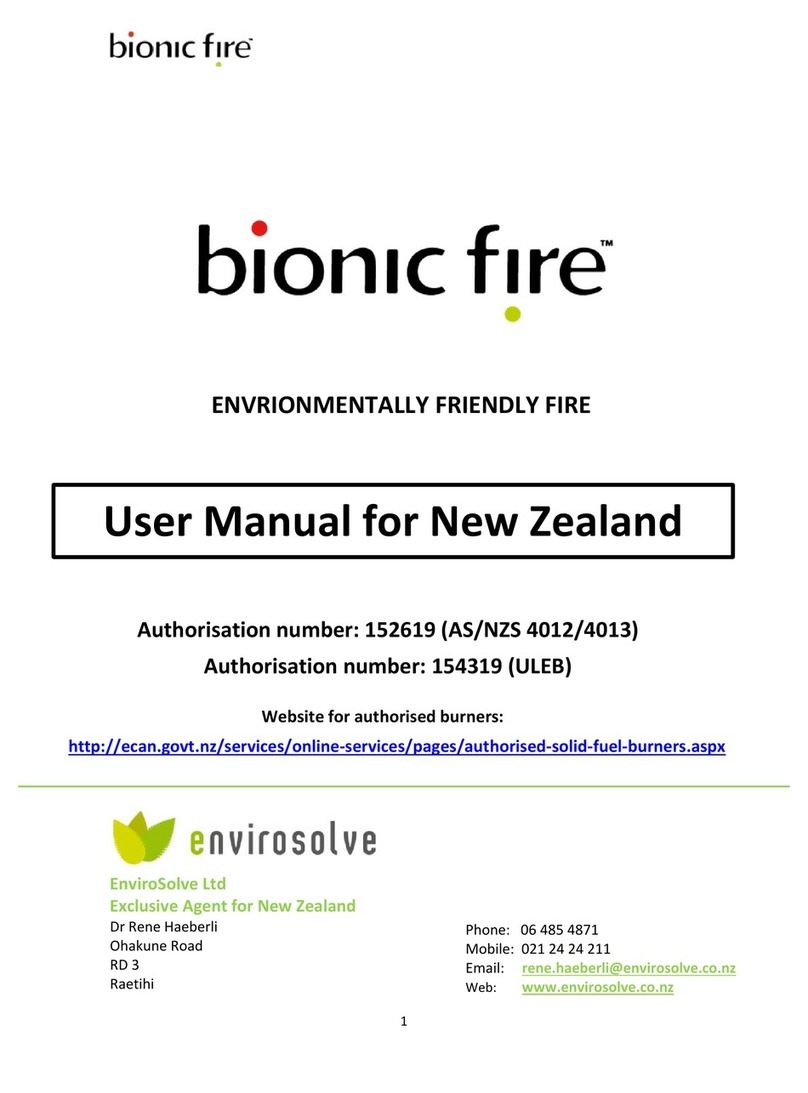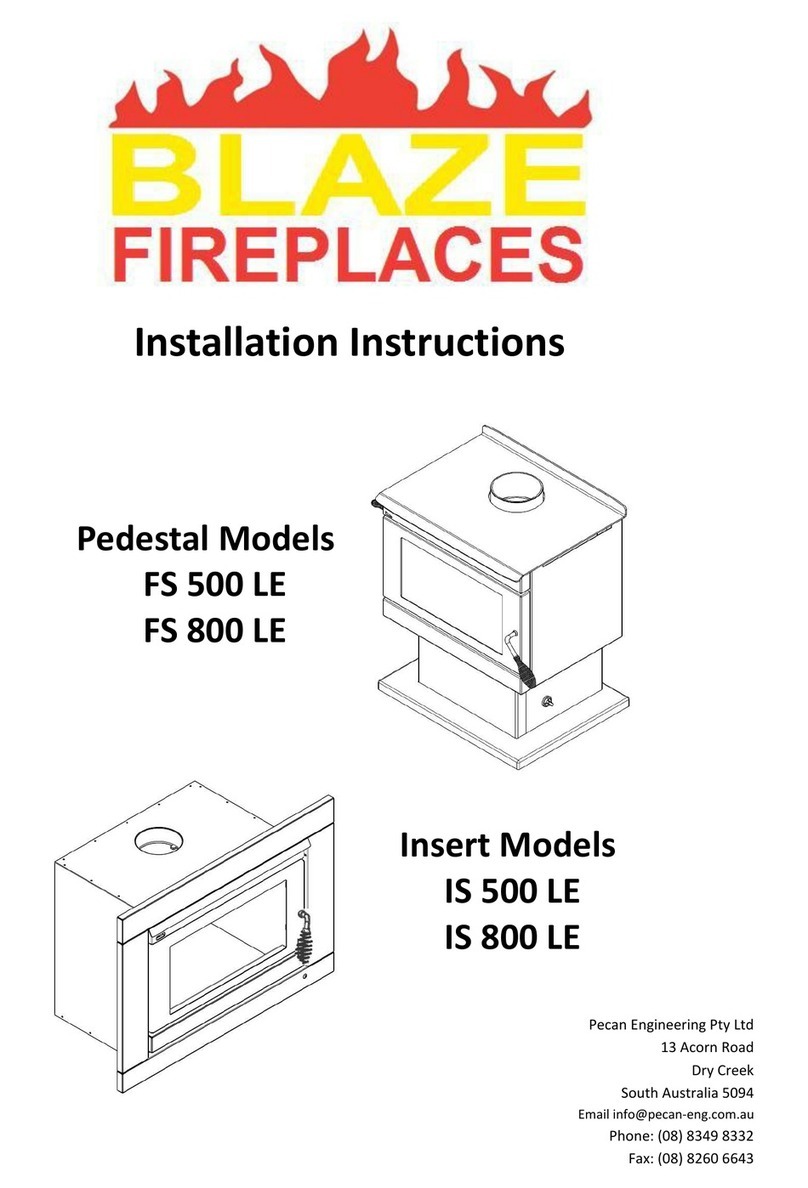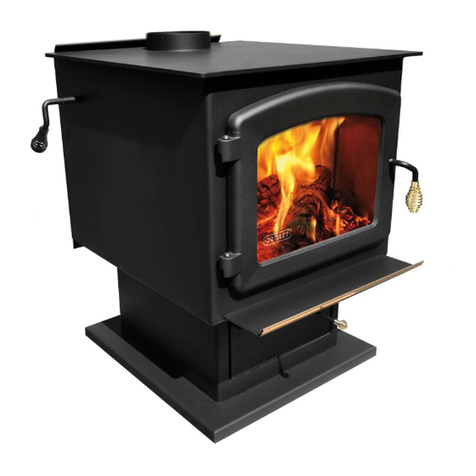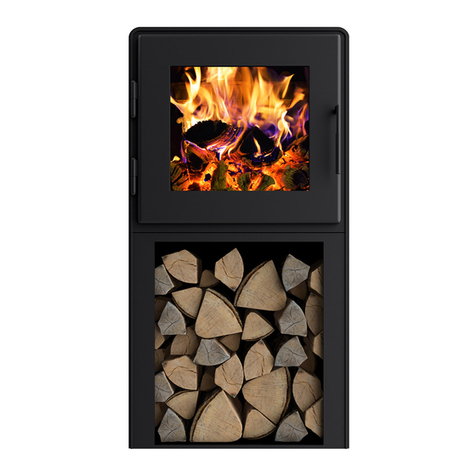Escea TFS Series Mounting instructions

Installation Instructions
and User Guide
TFS650 & TFS1000
FREE-STANDING SOLID FUEL BURNER
630592_1

WARRANTY REPAIR AND ANNUAL SERVICING
Please contact Escea if you require warranty work. Warranty repair work must be carried
out by a recognised Escea woodfire installer. It is recommended that recognised Escea
Wood Fire Installers are also used to carry out annual servicing requirements (particularly
during the warranty period). For contact details of recognised Escea Wood Fire Technicians
in your area, or for replacement parts, please contact the retailer from whom the appliance
was purchased from, or visit our website.
All installation work must comply to AS/NZS 2918:2018 Domestic solid fuel burning
appliances- Installation AND these installation instructions. Any work undertaken that
does not comply to AS/NZS 2918:2018 AND these installation instructions will not
qualify for the Escea warranty. Escea will not be accountable for any unsafe installation
that does not comply to AS/NZS 2918:2018.
Manufactured by: Escea Ltd, PO Box 5277 Dunedin NZ, Ph: +64 3 478 8220
For contact details of your local Escea distributor or dealer, please visit www.escea.com,
From Australia, please visit www.escea.com.au, call AU: 1800 460 832 or WA: 1800 730

CONTENTS
A Safety Information 4
B Product Details 6
C Installation Process 10
D Woodfire Operation 34
E Maintenance & Servicing 41
F Troubleshooting 55
G General Warranty Terms & Conditions 56
H Service History & Data Plate 59

4
AA SAFETY INFORMATION
ͳThe appliance should be allowed to cool
ͳDo not operate without fully assembling all
ͳ
ͳDo not operate appliance before reading and

55
A
ͳ
ͳ
ͳ
be carefully supervised when they are in the
individuals out of the room and away from hot
ͳ
ͳ
ͳ
ͳ
ͳ
children and dispose of the material in a safe
ͳ
ͳ
ͳThis appliance is designed to burn natural
ͳ
ͳ
ͳ
ͳ
ͳDo not let the appliance become hot enough
ͳ
ͳ
ͳ
maintained when building a mantel or shelves
on the wall or in the air above the appliance
ͳThe appliance must be installed using only
the building materials as approved by the
ͳ
within 1 meter of the product that is

6
B
B PRODUCT DETAILS
B1 Product Description
The TFS series is a free-standing wood fire.
B2 Product Dimensions
The TFS series consists of the TFS650 and TFS1000 fireplace. Plinths are available for
purchase to go along with the free-standing woodfire.
GRC plinths (Glassfibre-Reinforced Concrete) are available for both TFS650 and
TFS1000 products. The TFS1000 and 1500mm GRC Plinths can be used for both
TFS650 and TFS1000 products. The sheetmetal plinth is only available for the TFS650
product.
Dimensions for each fireplace and plinth options are available in the following pages.
For more detail, view architectural drawings at www.escea.com
TFS650 Fire Dimensions:
606mm
483mm
605mm
200mm
150mm
650mm
291mm
TOP VIEW
689mm
ISOMETRIC VIEW
FRONT VIEW
SIDE VIEW
FLUE PIPE
COMBUSTION
AIR INLET PIPE
506mm

77
B
TFS1000 Fire Dimensions:
Sheetmetal Base 650W Dimensions:
940mm
459mm
988mm
200mm
150mm
506mm
494
240mm
606mm
566mm
83mm
609mm
TOP VIEW
FRONT VIEW SIDE VIEW
FLUE PIPE
COMBUSTION
AIR INLET PIPE
ISOMETRIC VIEW
302mm
292mm
648mm
506mm
106mm
656mm
TOP VIEW
FRONT VIEW

8
8
B
Plinth 650W Dimensions:
Plinth 1000W Dimensions:
540
245mm 506mm
650mm
300mm
FRONT VIEW
TOP VIEW
884mm
320mm 506mm
994mm
FRONT VIEW
TOP VIEW
375mm

99
B
Plinth 1500W Dimensions:
B2 Specifications Table
TFS650:
Fuel Type Hardwood
Average Particulate Emission (g/kg) 0.97
Overall Average Eciency (%) 68.63
Maximum Average Heat Output (kW) 6.75
TFS1000:
Fuel Type Hardwood
Average Particulate Emission (g/kg) 1.00
Overall Average Eciency (%) 61.88
Maximum Average Heat Output (kW) 8.77
225mm
1350mm
1500mm
506mm
375mm
FRONT VIEW
TOP VIEW

10
C
C INSTALL ATION PROCESS
C1 Installation - General
ͳ
ͳ
of fuel and burn the appliance with the air
control fully open for an hour as the appliance
moisture is being drawn from the appliance
and it will be necessary to build several hot

1111
C
C2 Safety Clearance Minimum Dimensions
If there is combustible flooring within 500mm of the appliance, a floor protector must be
installed.
If there is combustible flooring directly in front of the appliance, the appliance must be
installed on one of Escea’s plinths/ bases, or another heat resistant structure of minimum
height H (as detailed below). Additionally, a floor protector of any suitable heat resistant
material (eg. steel, glass etc) must be installed to prevent any ash contacting the floor. The
floor protector must extend not less than 300mm from the front of the appliance and not
less than 200mm from each side of the appliance.
Dimension H can be reduced if the product is installed over an insulating, heat resistant
floor complying with the requirements of AS/NZS 2918:2018 section 3.3.3.
TFS650 Clearances:
A
(Back)
(mm)
B
(Side)
(mm)
C
(Floor
Protector
Front)
(mm)
D
(Floor
Protector
Side)
(mm)
E
(Flue
Centre
to Side)
(mm)
F
(Flue
Centre
to Back)
(mm)
G
(Top to
Ceiling)
(mm)
H
(Oset
height
from floor)
(mm)
Parallel
Position
200 320 300 200 645 415 1495 300
Corner
Position
100 100 300 200 490 490 1495 300
TFS1000 Clearances:
A
(Back)
(mm)
B
(Side)
(mm)
C
(Floor
Protector
Front)
(mm)
D
(Floor
Protector
Side)
(mm)
E
(Flue
Centre
to Side)
(mm)
F
(Flue
Centre
to Back)
(mm)
G
(Top to
Ceiling)
(mm)
H
(Oset
height
from floor)
(mm)
Parallel
Position
200 370 300 200 864 440 1420 375

12
12
C
Parallel Position
Corner Position
F
E
B
A C
D
A
B
D
C
E
F

1313
C
Height Clearances
Flue Clearances
At the ceiling and roof penetrations, it is permitted to have a combustible material hard
up against the 250mm dia galvanised liner. However the material must be no thicker than
20mm. At all other points, a minimum clearance of 25mm between the 250mm liner
and any combustible material must be maintained. Note: the Escea ceiling plate must be
installed to comply.
G
250mm GALVANISED LINER
25mm
Ceiling
Bottom of 250mm dia liner
flush with bottom of ceiling 200mm PAINTED FLUE

14
14
C
C3 Appliance Installation
Place the floor protector on the floor. Ensure that the floor protector is properly
centred to the location of the flue exit hole on the ceiling. Place the plinth or base on
the floor protector once the location of floor protector is set.
*Note: Safety clearance requirements for the woodfire must be taken into account
when setting the floor protector location.
Secure the plinth/ base and floor protector to the floor. Use 4x suitable bolts (M6
minimum) through the pre-drilled holes on the plinth and floor protector (circled
below). For concrete floors, concrete screws or dynabolts must be used.

1515
C
If installing onto one of the Escea Plinths, drill holes for mounting the fire, as per the
schematics below. If installing onto the Escea base, this will not be necessary as the
base already has mounting holes in the sheetmetal.
Note: if installing onto the 1500W Plinth, drill the same holes for the product, but
oset to where the fire is being positioned on the plinth.
DRILL HOLES THROUGH
GRC PLINTH TO SECURE
THE WOODFIRE PRODUCT
TO THE PLINTH

16
16
C
Place the appliance on top of the plinth and secure it to the plinth. Use the supplied 4x
M8x50 Hex bolts and 4x M8 x 32 washers to bolt through the plinth to the appliance.
*Note: Before placing the fire on the plinth, pre-drill 3x 3.3mm dia flue fixing holes on
both the fireplace Ø150mm and Ø200mm spigots.
USE M8 x 32 WASHER AND
M8 x 50 BOLT HEX BOLT FOR
EACH HOLE
2x HOLES ON EACH SIDE
Connect 3x pieces of the 1219mm long, Ø150mm flue pipe together to create a long
flue pipe. Drill through flue pipes and use a minimum of 3x SS rivets to connect flue
pipes together.
Place Ø150mm flue spiders around each of the Ø150mm flue pipe. Tighten the screws
and nuts to secure the spiders to the flue pipes. Drill through spider and flue pipes and
use a minimum of 3x SS rivets to further secure the spiders to flue.
Connect 3x pieces of the 1219mm long, Ø200mm flue pipe together to create a long
flue pipe. Drill through flue pipes and use the provided rivets to connect flue pipes
together.
Place Ø200mm flue spiders around each of the Ø200mm flue pipe. Tighten the
screws and nuts to secure the spiders to the flue pipes. Drill through spider and flue
pipes and use a minimum of 3x SS rivets to further secure the spiders to flue.
*Note: For more information regarding flue installation and minimum requirements,
please refer to section C5.

1717
C
Place the Escea ceiling plate over the spigots on the fire (folds pointing upwards). The
ceiling plate is supplied with the Escea Freestanding Flue Kit.
Position the long Ø150mm flue pipe (with the crimped end pointing downwards) into
the inner spigot. Use a minimum of 3x rivets to fasten the Ø150mm flue pipe through
pre-drilled holes on the Ø150mm spigot.
Position the long Ø200mm flue pipe (with the crimped end pointing downwards) into
the outer spigot. Use a minimum of 3x rivets to fasten the 200mm flue pipe through
pre-drilled holes on the outer spigot.
*Note: For more information regarding flue installation, please refer to section C4.
150
PLACE 150mm SPACER HERE
200
MINIMUM 1600mm
PLACE 200mm SPACER HERE

18
18
C
Secure the ceiling plate on to the ceiling. Use the 4x supplied machine pozi screws and
4x 12mm ceramic spacer.
Cut one of the Ø250mm galvanised liners from a length of 1219mm length to match
the required liner length. Then connect the 2 pieces of the Ø250mm liners together to
create a long liner pipe. Use a minimum of 3x SS rivets to connect flue pipes together.
Position the Ø250mm flue liners above the ceiling plate (with the crimped end
pointing upwards). Align the Ø250mm liner so that the end is flush with the ceiling
and attach the flue liner to ceiling and roof beams using appropriate fasteners. Note:
above the ceiling penetration and below the roof penetration, a 25mm clearance to any
combustible material must be maintained.
For more information regarding flue installation, please refer to section C4.

1919
C
Install the back vermiculite panel by tilting the panel and placing the bottom edge of
the back panel above the ember air plenum. Carefully push the top of the back panel
towards the back wall of the firebox.
*Note: Please hold the back panel in place while placing the side panels in place to
prevent it from tipping over.
*Note: Please refer to the diagram below for the correct orientation of the back
vermiculite panel during installation to the firebox. The door has been removed for
clarity.
THIS SURFACE IS VISIBLE
FROM THE FRONT
ISOMETRIC VIEW
BACK SURFACE OF THE
VERMICULITE PANEL
FRONT SURFACE
OF THE
VERMICULITE PANEL
BACK SURFACE
OF THE
VERMICULITE PANEL
THIS CHAMFER IS
NOT VISIBLE
SIDE VIEW

20
20
C
Install the left and right side vermiculite panels next by placing the panels on the sides
above the firebox base. Carefully push the top of the side panels towards the side walls
of the firebox.
*Note: Please refer to the diagram below for the correct orientation of the side
vermiculite panels during installation to the firebox. The door has been removed for
clarity.
THIS SURFACE IS VISIBLE
FROM THE TOP
ISOMETRIC VIEW
CHAMFERS ON THE
BOTTOM EDGE
BACK SURFACE OF THE
VERMICULITE PANEL
THIS CHAMFER IS
NOT VISIBLE
THIS CHAMFER IS
NOT VISIBLE
FRONT SURFACE OF THE
VERMICULITE PANEL
TOP VIEW
This manual suits for next models
2
Table of contents
Popular Wood Stove manuals by other brands
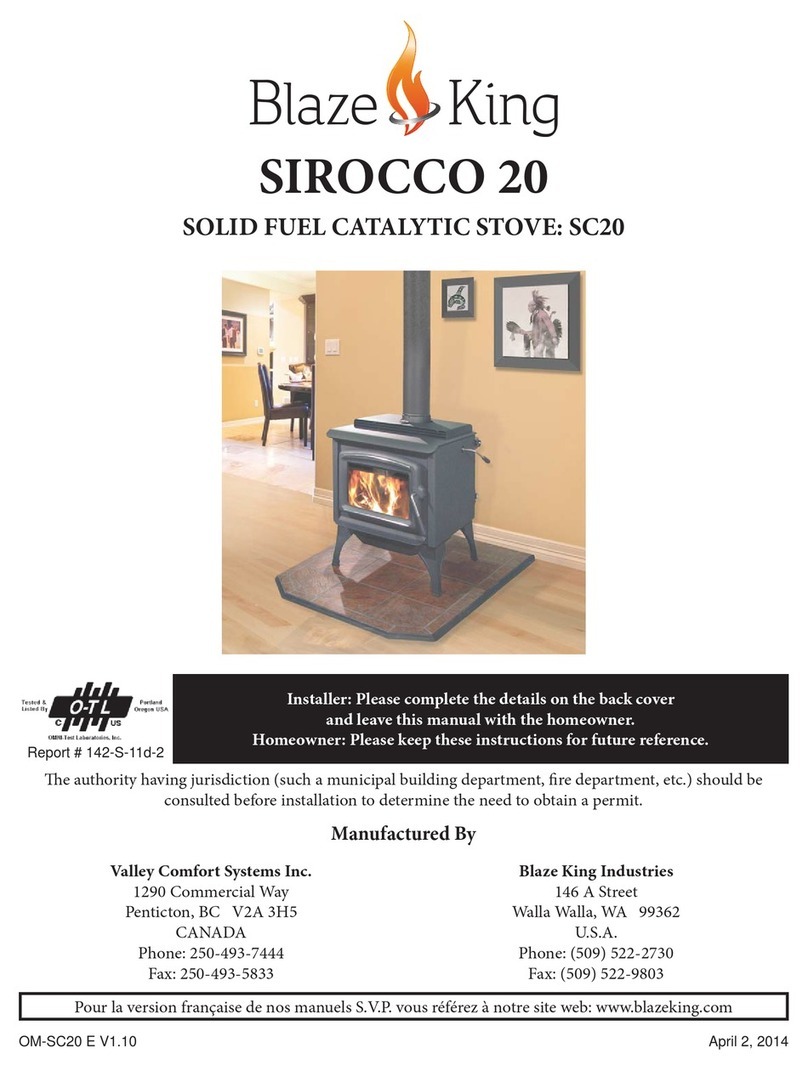
Blaze King
Blaze King SIROCCO 20 manual
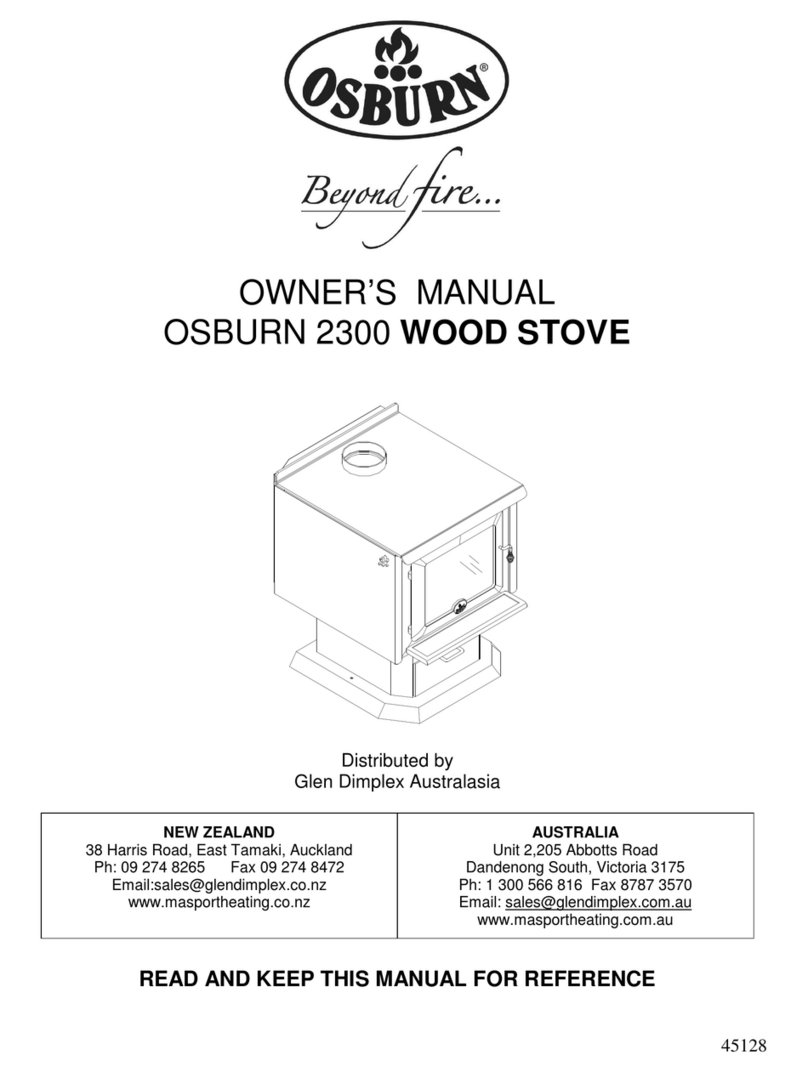
Osburn
Osburn 2300 owner's manual

Vermont Castings
Vermont Castings The Aspen 1920 Installation & operating manual

Drolet
Drolet HERITAGE owner's manual

Blaze King
Blaze King BOXER 24 Operation & installation manual
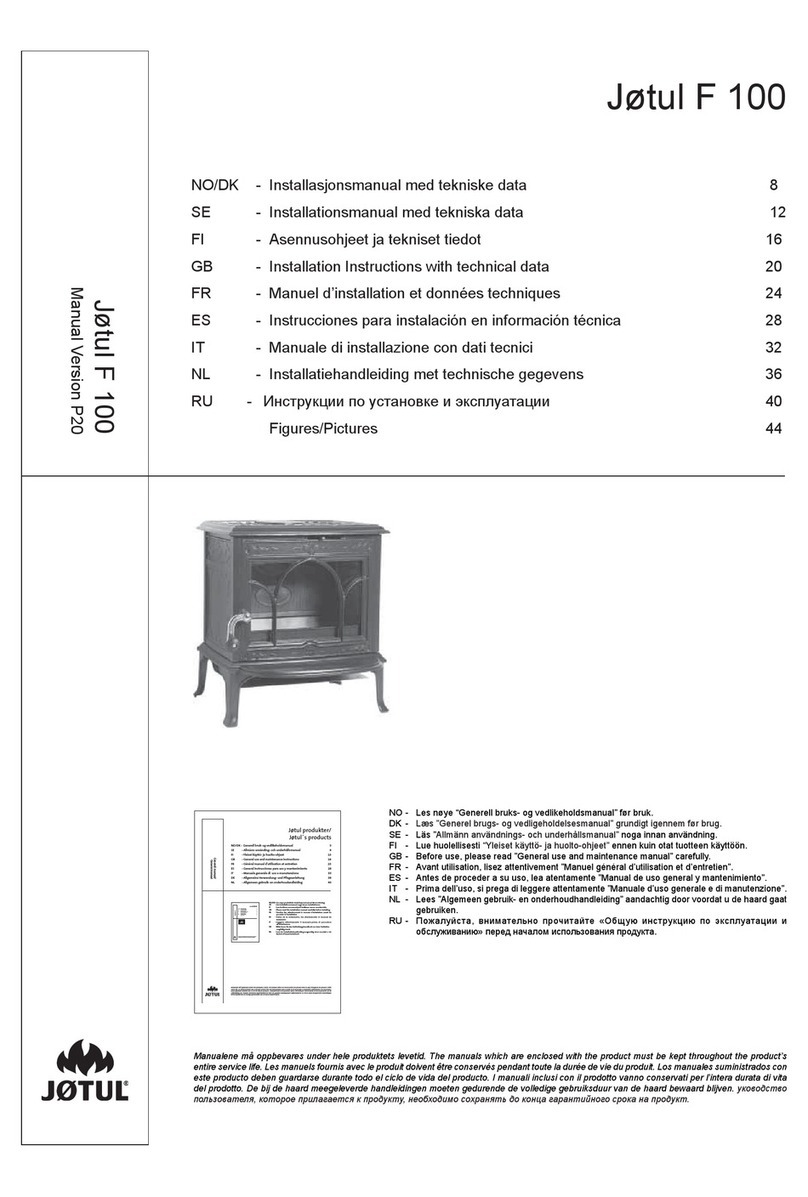
Jøtul
Jøtul F 100 Nordic Installation instructions with technical data

Vermont Castings
Vermont Castings Challenger VSW40 owner's manual
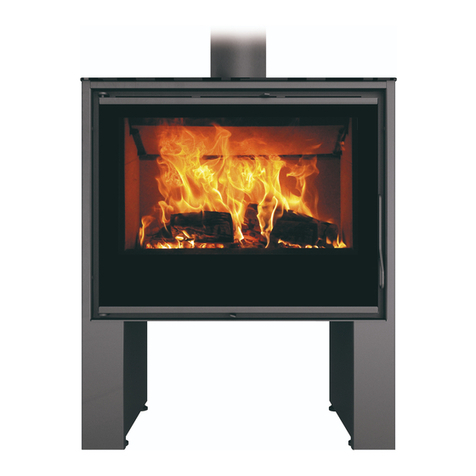
CARBEL
CARBEL ARES Manual for use and maintenance
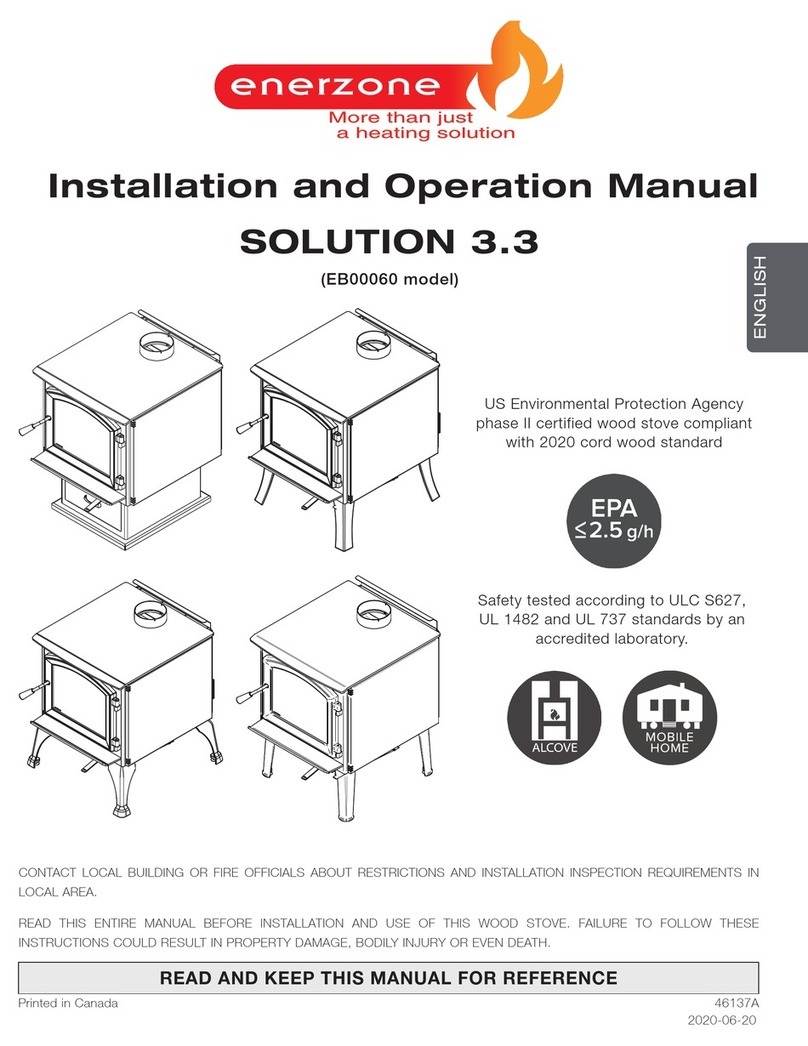
Enerzone
Enerzone EB00060 Installation and operation manual
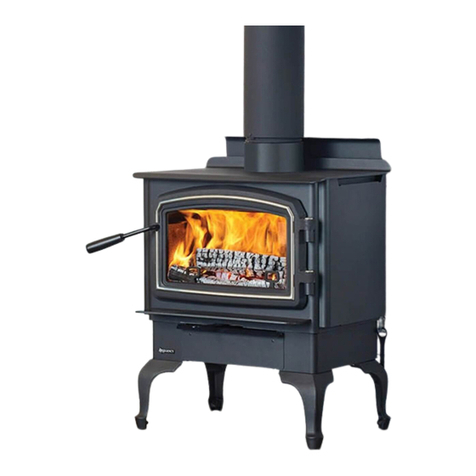
Regency
Regency F1100S Owners & installation manual
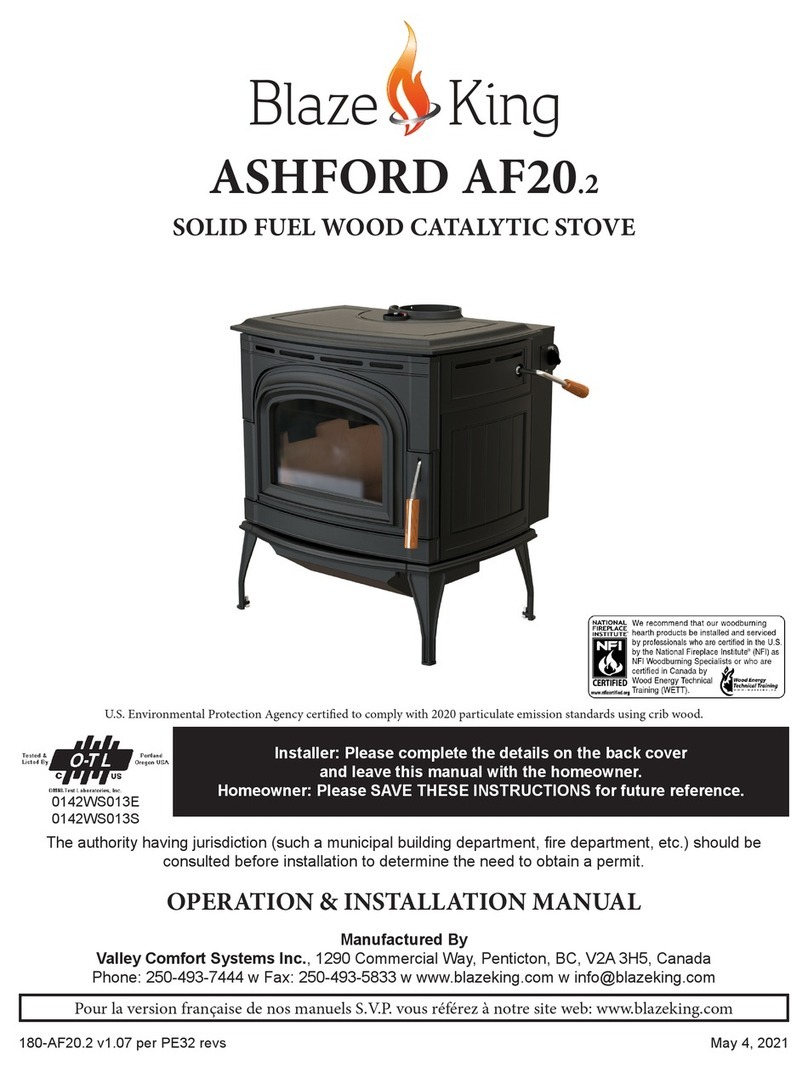
Blaze King
Blaze King ASHFORD AF20.2 Operation & installation manual
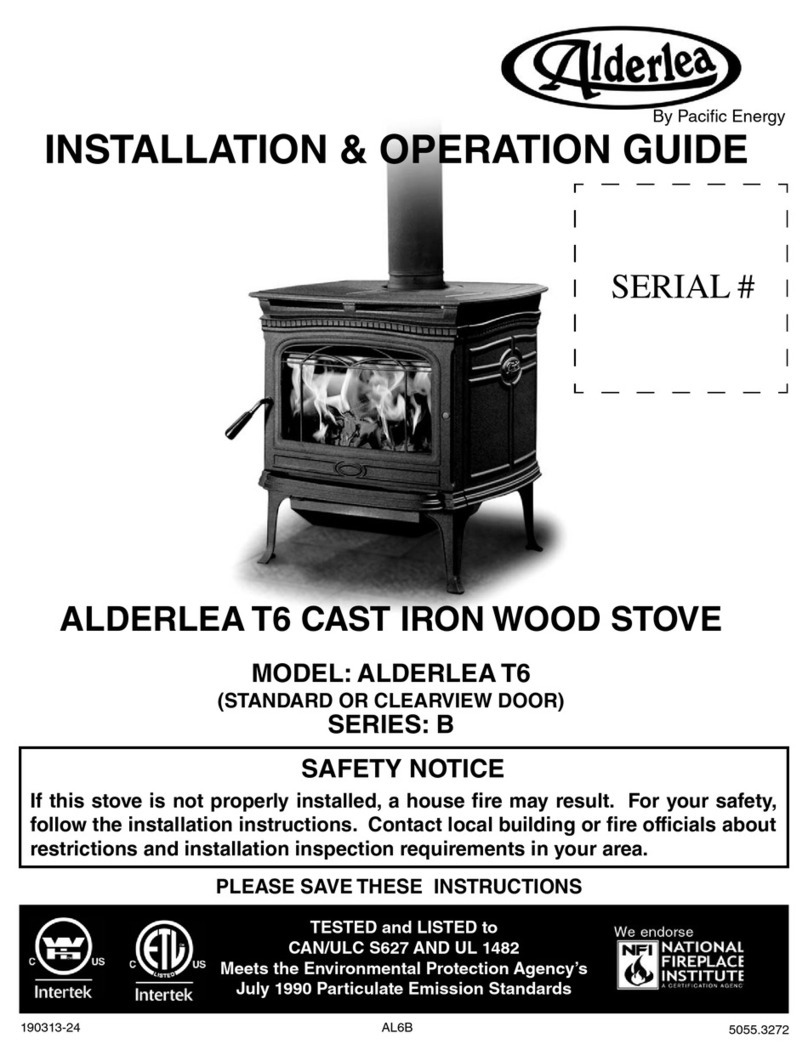
Alderlea
Alderlea T6 Installation & operation guide
